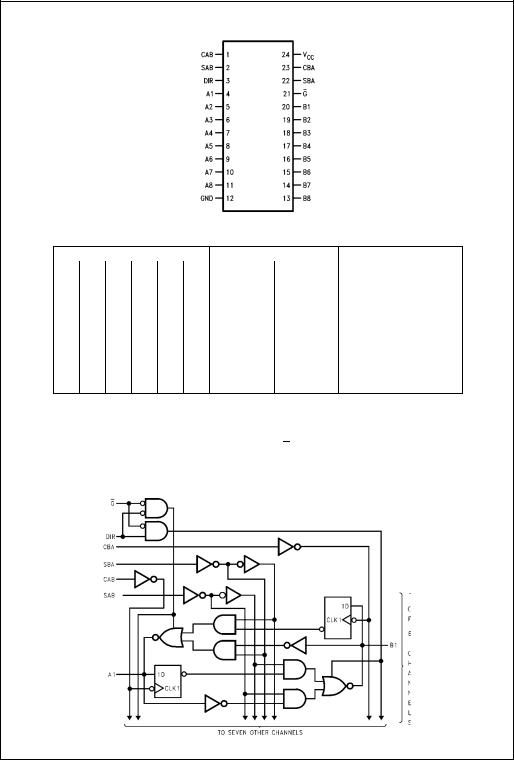Fairchild Semiconductor DM74ALS646WMX, DM74ALS646WM, DM74ALS646NT Datasheet

October 1986
Revised February 2000
DM74ALS646
Octal 3-STATE Bus Transceiver and Register
General Description
This device incorporates an octal bus transceiver and an octal D-type register configured to enable multiplexed transmission of data from bus to bus or internal register to bus.
This bus transceiver features totem-pole 3-STATE outputs designed specifically for driving highly-capacitive or relatively low-impedance loads. The high-impedance state and increased high-logic level drive provides this device with the capability of being connected directly to and driving the bus lines in a bus-organized system without the need for interface or pull-up components. They are particularly attractive for implementing buffer registers, I/O ports, bidirectional bus drivers, and working registers.
The registers in the DM74ALS646 are edge-triggered D- type flip-flops. On the positive transition of the clock (CAB or CBA), the input bus data is stored into the appropriate register. The CAB input controls the transfer of data into the A register and the CBA input controls the B register.
The SAB and SBA control pins are provided to select whether real-time data or stored data is transferred. A LOW input level selects real-time data, and a HIGH level selects stored data. The select controls have a “make before break” configuration to eliminate a glitch which would normally occur in a typical multiplexer during the transition between store and real-time data.
The enable G and direction control pins provide four modes of operation: real-time data transfer from bus A to B, realtime data transfer from bus B to A, real-time bus A and/or B data transfer to internal storage, or internally stored data transfer to bus A or B.
When the enable G pin is LOW, the direction pin selects which bus receives data. When the enable G pin is HIGH, both buses become disabled yet their input function is still enabled.
Features
■Switching specifications at 50 pF
■Switching specifications guaranteed over full temperature and VCC range
■Advanced oxide-isolated, ion-implanted Schottky TTL process
■3-STATE buffer outputs drive bus lines directly
■Multiplexed real-time and stored data
■Independent registers for A and B buses
Ordering Code
Order Number |
Package Number |
Package Description |
|
|
|
DM74ALS646WM |
M24B |
24-Lead Small Outline Integrated Circuit (SOIC), JEDEC MS-013, 0.300 Wide |
|
|
|
DM74ALS646NT |
N24C |
24-Lead Plastic Dual-In-Line Package (PDIP), JEDEC MS-100, 0.300 Wide |
|
|
|
Devices also available in Tape and Reel. Specify by appending the suffix letter “X” to the ordering code.
Register and Transceiver Bus STATE-3 Octal DM74ALS646
© 2000 Fairchild Semiconductor Corporation |
DS009172 |
www.fairchildsemi.com |

DM74ALS646
Connection Diagram
Function Table
|
|
|
|
Inputs |
|
|
Data I/O (Note 1) |
Operation or Function |
|||
|
|
|
DIR CAB CBA SAB SBA |
A1 thru A8 |
B1 thru B8 |
||||||
G |
|||||||||||
|
|||||||||||
|
|
|
|
|
|
|
|
|
|
||
|
X |
X |
− |
X |
X |
X |
Input |
Not Specified |
Store A, B Unspecified |
||
|
|
|
|
|
|
|
|
|
|
||
|
X |
X |
X |
− |
X |
X |
Not Specified |
Input |
Store B, A Unspecified |
||
|
|
|
|
|
|
|
|
|
|
||
|
H |
X |
− |
− |
X |
X |
Input |
Input |
Store A and B Data |
||
|
|
|
|
|
|
|
|
|
|
||
|
H |
X |
H/L |
H/L |
X |
X |
Input |
Input |
Isolation, Hold Storage |
||
|
|
|
|
|
|
|
|
|
|
||
|
L |
L |
X |
X |
X |
L |
Output |
Input |
Real-Time B Data to a Bus |
||
|
|
|
|
|
|
|
|
|
|
||
|
L |
L |
X |
H/L |
X |
H |
Output |
Input |
Stored B Data to a Bus |
||
|
|
|
|
|
|
|
|
|
|
||
|
L |
H |
X |
X |
L |
X |
Input |
Output |
Real-Time A Data to B Bus |
||
|
|
|
|
|
|
|
|
|
|
||
|
L |
H |
H/L |
X |
H |
X |
Input |
Output |
Stored A Data to B Bus |
||
H = HIGH Logic Level
L = LOW Logic Level
X = Don’t Care (Either LOW or HIGH Logic Levels including transitions) H/L = Either LOW or HIGH Logic Level excluding transitions
− = Positive going edge of pulse
Note 1: The data output functions may be enabled or disabled by various signals at the G and DIR inputs. Data input functions are always enabled, i.e., data at the bus pins will be stored on every LOW-to-HIGH transition on the clock inputs.
Logic Diagram
www.fairchildsemi.com |
2 |
